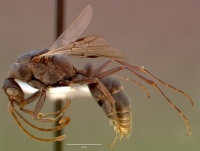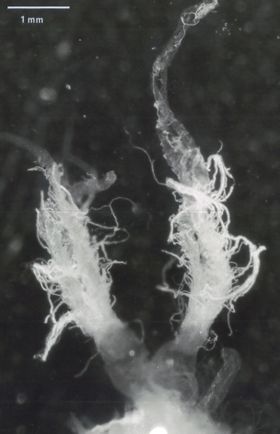Ophthalmopone berthoudi
| Ophthalmopone berthoudi | |
|---|---|

| |
| Scientific classification | |
| Kingdom: | Animalia |
| Phylum: | Arthropoda |
| Class: | Insecta |
| Order: | Hymenoptera |
| Family: | Formicidae |
| Subfamily: | Ponerinae |
| Tribe: | Ponerini |
| Genus: | Ophthalmopone |
| Species: | O. berthoudi |
| Binomial name | |
| Ophthalmopone berthoudi Forel, 1890 | |
| Subspecies | |
| |
| At a Glance | • Gamergate • Termite specialist |
Identification
Distribution
Latitudinal Distribution Pattern
Latitudinal Range: 0.29° to -27.5569°.
| North Temperate |
North Subtropical |
Tropical | South Subtropical |
South Temperate |
- Source: AntMaps
Distribution based on Regional Taxon Lists
Afrotropical Region: Kenya, Namibia, Zimbabwe, Zimbabwe.
Distribution based on AntMaps
Distribution based on AntWeb specimens
Check data from AntWeb
Countries Occupied
| Number of countries occupied by this species based on AntWiki Regional Taxon Lists. In general, fewer countries occupied indicates a narrower range, while more countries indicates a more widespread species. |

|
Estimated Abundance
| Relative abundance based on number of AntMaps records per species (this species within the purple bar). Fewer records (to the left) indicates a less abundant/encountered species while more records (to the right) indicates more abundant/encountered species. |

|
Biology
This queenless ant hunts termites exclusively, and foragers do not cooperate (Peeters & Crewe 1987). Colonies are polydomous, distributed over 2-7 nests separated by distances varying from 30cm to 75m. There is frequent relocation of workers and brood among nests (186±151 workers, range 20-840, n=34 nests excavated).
Life History Traits
- Mean colony size: 400 (Peeters & Crewe, 1987; Beckers et al., 1989)
- Foraging behaviour: solitary forager (Peeters & Crewe, 1987; Beckers et al., 1989)
Castes
Male behaviour in this queenless ant was studied in the field (Peeters & Crewe 1986). During several weeks of the year, a few males (1-8) flew off daily from each of a number of nests examined. Copulation with young workers occurs inside nests after foreign males succeed to enter.
In 34 nests excavated from Mkuze (northern Zululand), 1-108 workers had sperm in their spermathecae and ovaries with yolky oocytes (549 workers dissected; Peeters & Crewe 1985). However a majority of these mated workers lacked one or more mature oocytes ready to be laid. Nests collected before the onset of mating season had few gamergates and their fecundity was higher.
Twelve nests were excavated near Hoedspruit (Limpopo province) and a total of 619 workers were dissected. The number of mated workers per nest ranged from 1 to 36, and ovarian activity varied according to how many were present in a nest (Sledge et al. 1996). In nests with high proportions of mated workers, they exhibited diverse behaviours (mainly brood-related) and in some cases could not be distinguished behaviourally from virgin workers. In nests with low proportions of gamergates, these were more fecund and did not participate in colony labour. The behavioural profile of gamergates is therefore linked to their reproductive physiology (Sledge et al. 1999).
Unlike other queenless ants where dominance interactions regulate reproductive activity among workers, there is no aggression in O. berthoudi, and mesh experiments showed that contact pheromones underlie regulation (Sledge et al. 2001).
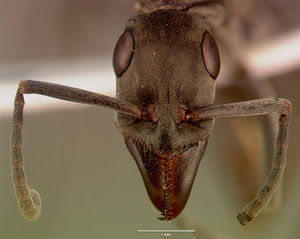 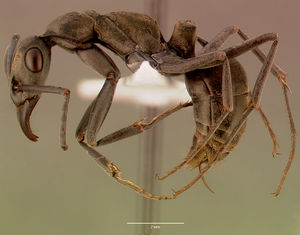 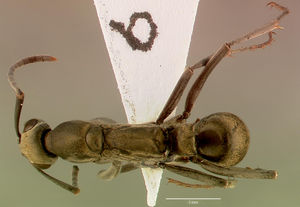 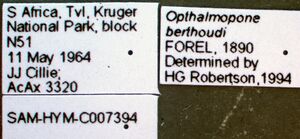
| |
| . | |
Nomenclature
The following information is derived from Barry Bolton's Online Catalogue of the Ants of the World.
- berthoudi. Ophthalmopone berthoudi Forel, 1890b: cxiii (w.) SOUTH AFRICA. Forel, 1894b: 76 (m.); Wheeler, G.C. & Wheeler, J. 1971b: 1203 (l.). Combination in Pachycondyla: Brown, in Bolton, 1995b: 303; in Ophthalmopone: Schmidt & Shattuck, 2014: 124. Current subspecies: nominal plus pubescens. See also: Arnold, 1915: 50; Peeters & Crewe, 1985: 29; Peeters & Crewe, 1987: 201.
Description
References
- Arnold, G. 1915. A monograph of the Formicidae of South Africa. Part I. Ponerinae, Dorylinae. Ann. S. Afr. Mus. 14: 1-159 (page 50, see also)
- Arnold, G. 1952a. New species of African Hymenoptera. No. 10. Occas. Pap. Natl. Mus. South. Rhod. 2: 460-493 (page 460, Junior synonym of strigulosa)
- Beckers R., Goss, S., Deneubourg, J.L., Pasteels, J.M. 1989. Colony size, communication and ant foraging Strategy. Psyche 96: 239-256 (doi:10.1155/1989/94279).
- Brown, W. L., Jr. 1995a. [Untitled. Taxonomic changes in Pachycondyla attributed to Brown.] Pp. 302-311 in: Bolton, B. A new general catalogue of the ants of the world. Cambridge, Mass.: Harvard University Press, 504 pp. (page 303, Combination in Pachycondyla)
- Esteves, F.A., Fisher, B.L. 2021. Corrieopone nouragues gen. nov., sp. nov., a new Ponerinae from French Guiana (Hymenoptera, Formicidae). ZooKeys 1074, 83–173 (doi:10.3897/zookeys.1074.75551).
- Forel, A. 1890b. Fourmis de Tunisie et de l'Algérie orientale. Ann. Soc. Entomol. Belg. 34:lxi-lxxvi. (page cxiii, worker described)
- Forel, A. 1894b. Abessinische und andere afrikanische Ameisen, gesammelt von Herrn Ingenieur Alfred Ilg, von Herrn Dr. Liengme, von Herrn Pfarrer Missionar P. Berthoud, Herrn Dr. Arth. Müller etc. Mitt. Schweiz. Entomol. Ges. 9: 64-100 (page 76, male described)
- Forel, A. 1901j. Variétés myrmécologiques. Ann. Soc. Entomol. Belg. 45: 334-382 (page 344, worker described [Unresolved junior secondary homonym of berthoudi Forel])
- Forel, A. 1913a. Fourmis de Rhodesia, etc. récoltées par M. G. Arnold, le Dr. H. Brauns et K. Fikendey. Ann. Soc. Entomol. Belg. 57: 108-147 (page 109, Race of punicosa)
- Forel, A. 1913b. Formicides du Congo Belge récoltés par MM. Bequaert, Luja, etc. Rev. Zool. Afr. (Bruss.) 2: 306-351 (page 306, male described)
- Peeters, C. 1984. Social organization, breeding biology and the process of reproductive differentiation in Ophthalmopone berthoudi Forel, a ponerine ant. Unpublished PhD thesis, University of the Witwatersrand, Johannesburg.
- Peeters, C., Crewe R. 1984. Insemination controls the reproductive division of labour in a ponerine ant. Naturwissenschaften 71: 50-51 (doi:10.1007/BF00365989).
- Peeters, C., Crewe, R.M. 1985. Worker reproduction in the ponerine ant Ophthalmopone berthoudi: an alternative form of eusocial organization. Behavioral Ecology and Sociobiology 18: 29-37 (doi:10.1007/BF00299235).
- Peeters, C.; Crewe, R. M. 1986. Male biology in the queenless ponerine ant Ophthalmopone berthoudi (Hymenoptera: Formicidae). Psyche, 93: 277-284.
- Peeters, C.; Crewe, R. M. 1987. Foraging and recruitment in ponerine ants: solitary hunting in the queenless Ophthalmopone berthoudi (Hymenoptera: Formicidae). Psyche (Camb.) 94: 201-214.
- Richter, A., Boudinot, B.E., Hita Garcia, F., Billen, J., Economo, E.P., Beutel, R.G. 2023. Wonderfully weird: the head anatomy of the armadillo ant, Tatuidris tatusia (Hymenoptera: Formicidae: Agroecomyrmecinae), with evolutionary implications. Myrmecological News 33: 35-75 (doi:10.25849/MYRMECOL.NEWS_033:035).
- Schmidt, C.A. & Shattuck, S.O. 2014. The higher classification of the ant subfamily Ponerinae (Hymenoptera: Formicidae), with a review of ponerine ecology and behavior. Zootaxa 3817, 1–242 (doi:10.11646/zootaxa.3817.1.1).
- Sledge, M., C. Peeters & R. Crewe 2001. Reproductive division of labour without dominance interactions in the queenless ponerine ant Pachycondyla (=Ophthalmopone) berthoudi. Insect. Soc. 48: 67-73.
- Sledge, M.F., C. Peeters & R.M. Crewe 1999. Fecundity and the behavioural profile of reproductive workers in the queenless ant Pachycondyla (=Ophthalmopone) berthoudi. Ethology 105: 303-316.
- Sledge, M.F., R.M. Crewe & C. Peeters 1996. On the relationship between gamergate number and reproductive output in the queenless ponerine ant Pachycondyla (=Ophthalmopone) berthoudi. Naturwissenschaften 83: 282-284.
- Wheeler, G. C.; Wheeler, J. 1971b. Ant larvae of the subfamily Ponerinae: second supplement. Ann. Entomol. Soc. Am. 6 64: 1197-1217 (page 1203, larva described)
References based on Global Ant Biodiversity Informatics
- Emery C. 1911. Hymenoptera. Fam. Formicidae. Subfam. Ponerinae. Genera Insectorum 118: 1-125.
- Forel A. 1890. Aenictus-Typhlatta découverte de M. Wroughton. Nouveaux genres de Formicides. Annales de la Société Entomologique de Belgique 34: cii-cxiv.
- Garcia F.H., Wiesel E. and Fischer G. 2013.The Ants of Kenya (Hymenoptera: Formicidae)Faunal Overview, First Species Checklist, Bibliography, Accounts for All Genera, and Discussion on Taxonomy and Zoogeography. Journal of East African Natural History, 101(2): 127-222
- Peeters, C. and R. Crewe. 1987. Foraging and recruitment in ponerine ants: Solitary hunting in the queenless Ophthalmopone berthoudi (Hymenoptera: Formicidae). Psyche 94:201-214.
- Prins A. J. 1963. A list of the ants collected in the Kruger National Park with notes on their distribution. Koedoe 6: 91-108.
- Prins A. J. 1964. Revised list of the ants collected in the Kruger National Park. Koedoe 7: 77-93.
- Santschi F. 1937. Résultats de la Mission scientifique suisse en Angola (2me voyage) 1932-1933. Fourmis angolaises. Revue Suisse de Zoologie. 44: 211-250.
- Weber N. A. 1943. The ants of the Imatong Mountains, Anglo-Egyptian Sudan. Bulletin of the Museum of Comparative Zoology 93: 263-389.
- Wheeler W. M. 1922. Ants of the American Museum Congo expedition. A contribution to the myrmecology of Africa. VIII. A synonymic list of the ants of the Ethiopian region. Bulletin of the American Museum of Natural History 45: 711-1004
